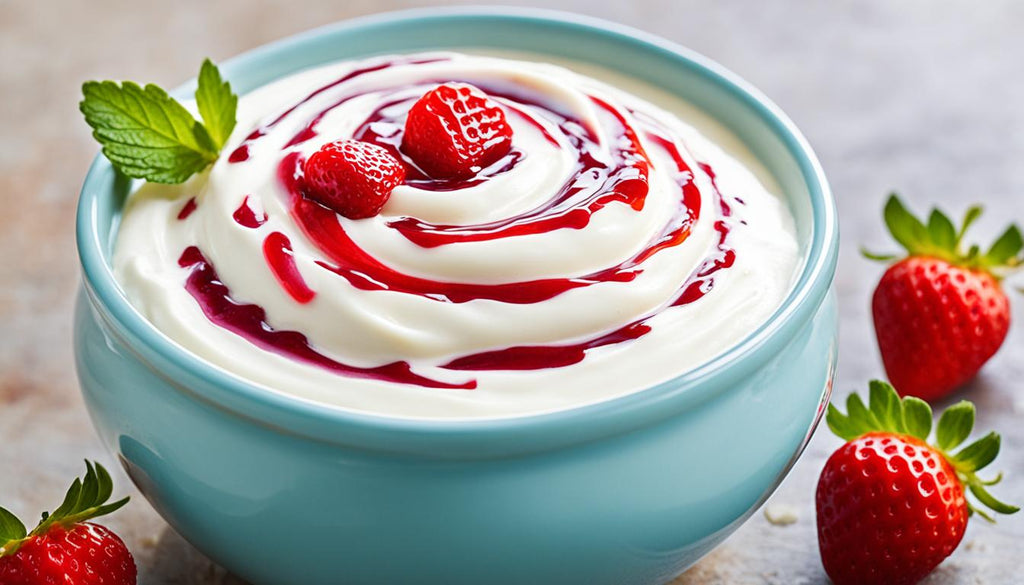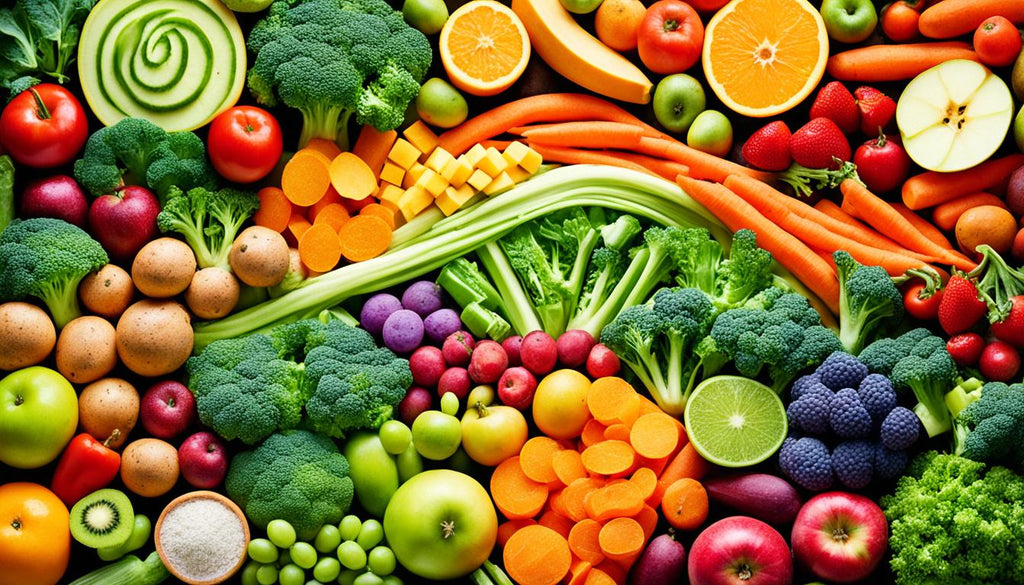
Unlocking the Secrets: How Polysaccharides Transform into Powerful Hydrocolloids
SUBSCRIBE TO OUR BLOG
Promotions, new products, and recipes.
Polysaccharides, often referred to as carbohydrates, have a fascinating capability to undergo a remarkable transformation, turning into powerful hydrocolloids. These hydrocolloids are water-soluble polymers that find extensive applications in the field of food science. From gel formation to acting as thickening agents and stabilizing agents, polysaccharides play a crucial role in modifying the texture and stability of various food products.
Key Takeaways:
- Polysaccharides have the ability to transform into hydrocolloids, which are water-soluble polymers used in the food industry.
- Hydrocolloids act as thickening agents, stabilizing agents, and contribute to gel formation in food products.
- Natural gums, such as alginates, pectin, cellulose, chitin, and glycogen, are examples of polysaccharides commonly used as hydrocolloids.
- The molecular structure of polysaccharides determines their functionality, influencing factors like viscosity.
- Polysaccharides offer a wide range of applications, not only in food science but also in pharmaceuticals, cosmetics, and more.
The Role of Polysaccharides in the Food Industry
Polysaccharides and hydrocolloids play a significant role in the food industry, serving as essential ingredients in various food products. These natural compounds contribute to the texture, stability, and sensory experience of the foods we consume.
Unlock the secrets of modernist cuisine. Explore our range of hydrocolloids and kitchen appliances today. Visit our product page now
One of the key functions of polysaccharides in the food industry is gel formation. They act as gel formers, transforming liquid ingredients into gels that provide structure and stability to products like jams, jellies, and fruit fillings. Additionally, polysaccharides serve as thickening agents, enhancing the viscosity of sauces, soups, and dressings. The unique molecular structures of polysaccharides allow them to create desirable textures and consistency in these food products.
Stabilizing agents are another vital role of polysaccharides in the food industry. They help maintain the stability and quality of food products, preventing phase separation and ensuring uniform distribution of ingredients. With their ability to bind water, polysaccharides assist in preventing syneresis, or the formation of liquid droplets in products like salad dressings and mayonnaise.
Natural gums, derived from plant extracts or animal extracts, are commonly used as polysaccharide ingredients in the food industry. Examples include alginates, obtained from seaweed, which are frequently used in dairy products and can improve the texture and stability of ice creams and yogurts. Pectin, found in fruits, is a crucial ingredient in the production of jams and jellies, providing them with their characteristic gel-like consistency. Gelatin, derived from animal sources, is widely used in confectionery products, imparting a smooth texture and enhancing mouthfeel.
Examples of Polysaccharides and their Applications in the Food Industry:
| Polysaccharide | Source | Application |
|---|---|---|
| Alginates | Seaweed | Stabilizer, thickener in dairy products, ice creams |
| Pectin | Fruits | Gelling agent in jams, jellies, and fruit fillings |
| Gelatin | Animal sources | Texturizer in confectionery products, jellies |
These examples highlight the diverse applications of polysaccharides in the food industry and their contribution to the sensory experience, stability, and quality of food products. Their versatility as natural gums derived from plant and animal sources makes them valuable ingredients in the formulation of various food products.

Hydrocolloids: Transforming Texture and Consistency
Hydrocolloids, derived from polysaccharides, have the remarkable ability to transform the texture and consistency of food products. These versatile substances act as thickening agents and emulsifiers, playing a crucial role in modifying the viscosity and flow properties of foods. The molecular weight of hydrocolloids is an important factor in determining their functionality, as higher molecular weights result in greater viscosity.
One of the key sources of hydrocolloids is natural gums, which are polysaccharides extracted from various plants and seeds. These natural gums, such as xanthan gum, guar gum, and agar, are commonly used in the food industry to enhance the texture and consistency of products.
Thickening Agents
Hydrocolloids are highly effective as thickening agents, providing the desired thickness and body to food products. By increasing the viscosity, hydrocolloids improve the mouthfeel and sensory experience of consuming various foods. They can be used in a wide range of applications, including sauces, dressings, soups, and desserts.
Emulsifiers
In addition to their thickening properties, hydrocolloids also function as emulsifiers, helping to stabilize and blend together ingredients that would not normally mix well. They create a stable suspension of oil and water, preventing separation and achieving a smooth and uniform texture in food products like salad dressings, mayonnaise, and ice cream.
Overall, hydrocolloids contribute significantly to the desired texture and consistency of food products, enhancing their appeal and quality. When used in combination with other ingredients and processing techniques, hydrocolloids offer endless possibilities in creating innovative and enjoyable culinary experiences.
Polysaccharides: Beyond Food Science
Polysaccharides and hydrocolloids are not limited to their applications in the food industry. These versatile compounds are also utilized in various other sectors, such as pharmaceuticals and cosmetics, contributing to advancements in technology, sustainability, and the overall well-being of individuals.
Pharmaceutical Applications
In the field of pharmaceuticals, polysaccharides play a vital role in controlled drug delivery systems. Their unique properties, such as biocompatibility and biodegradability, make them suitable candidates for encapsulating and releasing drugs in a controlled manner. Polysaccharides act as biodegradable polymers, ensuring the safe delivery of medications to targeted sites within the body, minimizing side effects, and maximizing therapeutic effectiveness.
Cosmetic Formulations
Polysaccharides are widely used in cosmetic formulations to enhance product texture and stability. They contribute to the luxurious feel, smoothness, and moisturizing properties of skincare products, hair care products, and makeup. Polysaccharides help improve product efficacy by providing excellent sensory characteristics and ensuring longer shelf life.
The image below illustrates the various applications of polysaccharides, including pharmaceutical and cosmetic formulations:
Environmental Impact
While polysaccharides offer numerous benefits, it's essential to consider the environmental impact of hydrocolloid production. The extraction and manufacturing processes of these compounds can have environmental implications, including energy consumption, waste generation, and water usage. To mitigate these effects, ongoing efforts are being made to develop sustainable practices, reduce waste, and minimize the carbon footprint associated with the production of polysaccharides and hydrocolloids.
To summarize, polysaccharides extend their influence beyond food science to contribute significantly to pharmaceutical and cosmetic industries. Additionally, the ongoing focus on sustainable practices highlights the importance of minimizing the environmental impact associated with their production.
The Health Benefits of Polysaccharides
Polysaccharides, particularly those that act as dietary fibers, offer numerous health benefits. They contribute to digestive health and help regulate blood sugar levels. Polysaccharides with thickening properties, such as those used in gluten-free baking, provide alternatives for individuals with dietary restrictions. The inclusion of dietary polysaccharides in the diet has been associated with improved gut health and reduced risk of chronic diseases. These natural compounds play a vital role in promoting overall well-being and are a valuable addition to a balanced diet.
Polysaccharides have gained recognition for their role in promoting digestive health. As dietary fibers, they assist in maintaining a healthy digestive system by promoting regular bowel movements and preventing constipation. Their ability to absorb water and add bulk to the stool contributes to regularity and overall gut health.
In addition to supporting digestive health, polysaccharides also play a key role in regulating blood sugar levels. When consumed as part of a balanced diet, polysaccharides provide a slow and steady release of glucose into the bloodstream, preventing rapid spikes in blood sugar. This can be especially beneficial for individuals with diabetes or those looking to manage their blood sugar levels.
Furthermore, polysaccharides with thickening properties, such as those used in gluten-free baking, offer alternatives for individuals with dietary restrictions. These hydrocolloids enhance the texture and consistency of gluten-free products, allowing individuals with gluten intolerance or celiac disease to enjoy a variety of baked goods without sacrificing taste or quality.
Key Health Benefits of Polysaccharides:
- Promote digestive health
- Regulate blood sugar levels
- Provide alternatives for gluten-free baking
- Contribute to a balanced diet
By incorporating dietary polysaccharides into the diet, individuals can experience improved gut health, better blood sugar regulation, and increased options for gluten-free baking. These health benefits make polysaccharides an important component of a healthy and inclusive diet.
Innovations and Future Trends in Polysaccharide Research
The field of polysaccharide research is constantly evolving, with ongoing innovations and future trends shaping the industry. Researchers are dedicated to exploring new sources of hydrocolloid polysaccharides and developing novel applications to revolutionize diverse sectors, including food, pharmaceuticals, and cosmetics.
Exploration of New Sources
Scientists and experts are actively investigating untapped sources of polysaccharides and hydrocolloids to uncover their potential benefits and applications. By studying polysaccharides derived from diverse organisms, such as marine plants, fungi, and bacteria, researchers are expanding the scope of possibilities for hydrocolloid utilization.
The exploration of these new sources contributes to biodiversity preservation while broadening the range of sustainable options available to various industries. Leveraging the rich diversity of natural resources holds great promise for the development of innovative solutions in the future.
Novel Applications
One of the driving forces behind polysaccharide research is the pursuit of novel applications in different industries. Beyond traditional uses in food, hydrocolloids are increasingly finding their way into pharmaceuticals and cosmetics, where their unique properties can enhance product performance and consumer experience.
In the pharmaceutical field, polysaccharides are being explored as excipients and carriers for controlled drug delivery systems. Their ability to form gels and encapsulate active ingredients opens new avenues for targeted therapies and improved patient outcomes.
In the cosmetics industry, hydrocolloids are being incorporated into formulations to enhance texture, stability, and sensory attributes of products. Their natural origin and biocompatibility make them an attractive choice for sustainable and eco-friendly cosmetic solutions.

Sustainability and Environmental Focus
As the world continues to prioritize sustainable practices, so too does polysaccharide research. Efforts are being made to develop biodegradable polymers from polysaccharides, reducing reliance on synthetic materials and minimizing environmental impact.
Additionally, researchers are focusing on optimizing production processes to minimize waste and energy consumption. By refining extraction techniques and employing green chemistry principles, polysaccharide production can become more sustainable and environmentally friendly.
Collaborative Research and Knowledge Sharing
The future of polysaccharide research lies in collaboration and knowledge sharing across academia, industry, and government institutions. By fostering interdisciplinary partnerships, researchers can leverage their collective expertise to drive innovation and address complex challenges.
International conferences, research symposiums, and academic publications play a crucial role in disseminating new insights and findings. By establishing a global network of researchers, the field of polysaccharide research can continuously evolve and inspire the next wave of innovations.
With the combination of exploring new sources, developing novel applications, focusing on sustainability, and promoting collaborative research, the future of polysaccharide research holds immense potential. The ongoing innovations and emerging trends in this field will continue to shape various industries, offering exciting possibilities for the future.
| Key Innovations | Potential Applications |
|---|---|
| Exploration of new sources | Food, pharmaceuticals, cosmetics |
| Development of novel applications | Controlled drug delivery systems, eco-friendly cosmetics |
| Focus on sustainability and environmental impact | Biodegradable polymers, waste reduction |
| Collaborative research and knowledge sharing | Academia, industry, government partnerships |
Conclusion
Polysaccharides and hydrocolloids are essential players in the food industry, revolutionizing the texture and consistency of food products while enhancing stability and quality. These versatile compounds offer more than just functional benefits; they also provide significant health advantages as dietary fibers and cater to individuals with specific dietary restrictions.
Looking ahead, ongoing innovations and future trends in the field of polysaccharide research hold tremendous promise. As researchers delve into new sources of hydrocolloid polysaccharides and explore novel applications, the food industry will witness exciting advancements. Additionally, the focus on sustainability and environmental impact will drive the development of biodegradable polymers and sustainable production practices.
The incredible power of polysaccharides in shaping the texture and stability of foods goes beyond the boundaries of the food industry. From pharmaceutical applications to cosmetic formulations, the impact of polysaccharides is far-reaching. As we continue to unlock the potential of these natural compounds, we can anticipate even greater innovations and future trends in various industries.
In conclusion, polysaccharides and hydrocolloids have become indispensable assets to the food industry, contributing to texture, consistency, and health benefits. With ongoing advancements and a growing emphasis on sustainability, the future of polysaccharides holds tremendous potential for transforming the way we experience and consume food, as well as shaping the evolution of other industries.
FAQ
What are polysaccharides and hydrocolloids?
Polysaccharides are macromolecules that can transform into hydrocolloids, which are water-soluble polymers commonly used in the food industry for gel formation, thickening, and stabilization purposes.
What is the role of polysaccharides in the food industry?
Polysaccharides, such as natural gums derived from plant and animal extracts, act as gel formers, thickening agents, and stabilizing agents in various food products, improving their texture and stability.
How do hydrocolloids transform the texture and consistency of food products?
Hydrocolloids, derived from polysaccharides, function as thickening agents and emulsifiers, modifying the viscosity and flow properties of foods to achieve the desired texture and consistency.
Are polysaccharides and hydrocolloids used in other industries?
Yes, polysaccharides and hydrocolloids have applications beyond the food industry, including pharmaceutical applications for controlled drug delivery and cosmetic formulations to enhance texture and stability.
What health benefits do polysaccharides offer?
Polysaccharides, particularly those acting as dietary fibers, contribute to digestive health and help regulate blood sugar levels. They also provide alternatives for individuals with dietary restrictions, such as those requiring gluten-free options.
What are some ongoing trends in polysaccharide research?
Researchers are constantly exploring new sources of hydrocolloid polysaccharides, developing novel applications, and focusing on sustainability and reducing the environmental impact of production processes.
What is the significance of polysaccharides and hydrocolloids in the food industry?
Polysaccharides and hydrocolloids play a crucial role in improving the texture, consistency, and stability of food products. They also offer health benefits, contribute to innovations, and shape future trends in the industry.
Source Links
- https://www.capecrystalbrands.com/pages/types-of-hydrocolloids
- https://www.linkedin.com/posts/pallavi-dubey-phd-3877b420_unlocking-the-hidden-power-of-bacterial-activity-7090314998182289408-IALz
- https://www.capecrystalbrands.com/blogs/cape-crystal-brands/new-book-beginners-guide-to-hydrocolloids
Well That's the Story. I hope it was helpful. Let's Hear Your Thoughts!
We've shared our insights, and now it's your turn! Have an opinion, a question, or a story to share about this article? Dive into the comments below and join the conversation. Your voice is a crucial part of this community, and we're eager to hear what you have to say.
Thought that was fascinating? Here’s another story you might like:
See: The Hydrocolloid Glossary
For further reading:
How Dutch Gum Transforms Coffee Waste into Culinary Magic
Every dish deserves the perfect texture to complement its flavors. Why settle for anything less than perfection? With Cape Crystal Brands Food Texture products, you don't have to. Whether you're crafting velvety sauces, glistening gels, or fluffy mousses, our range ensures you get the consistency you desire every single time.
Don't just cook—create masterpieces. Dive into the world of culinary textures and elevate every meal. Shop now and experience the magic of Cape Crystal!
🛍️ Click Here to Explore Cape Crystal Brands Food Texture Products!

|
About the Author Ed is the founder of Cape Crystal Brands, editor of the Beginner’s Guide to Hydrocolloids, and a passionate advocate for making food science accessible to all. Discover premium ingredients, expert resources, and free formulation tools at capecrystalbrands.com/tools. — Ed |
Enjoyed this post? Subscribe to The Crystal Scoop
Food-science tips, ingredient know-how, and recipes. No spam—unsubscribe anytime.
- Choosing a selection results in a full page refresh.




